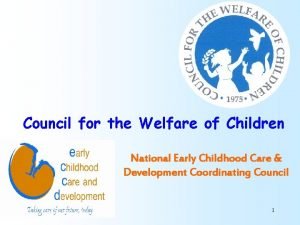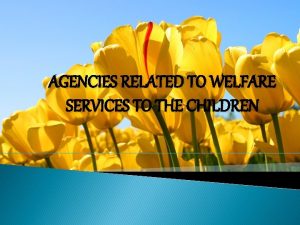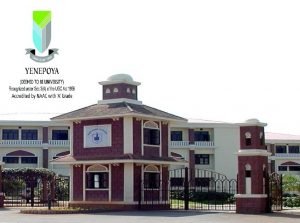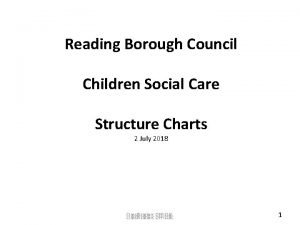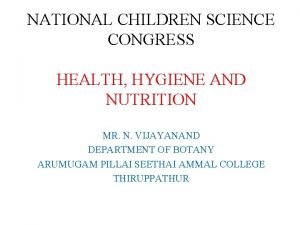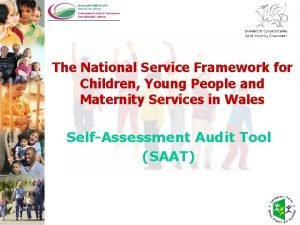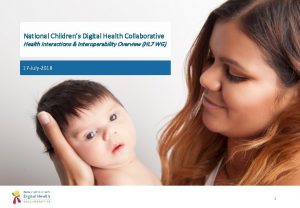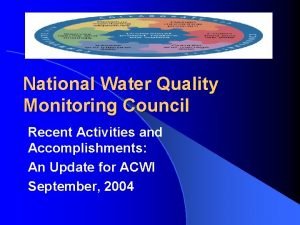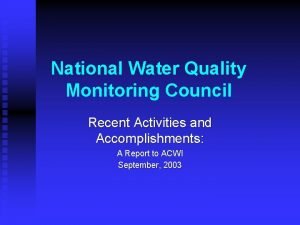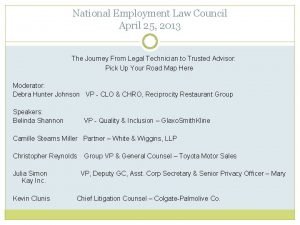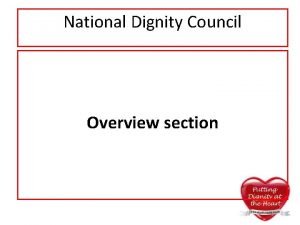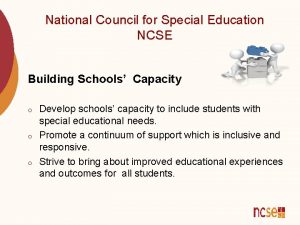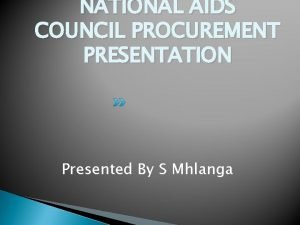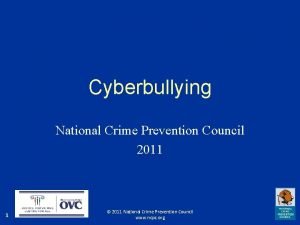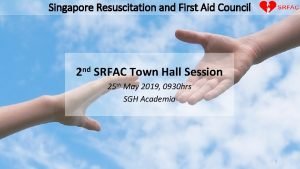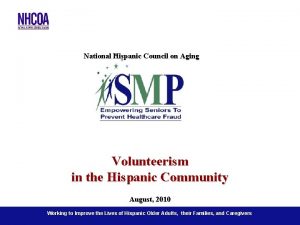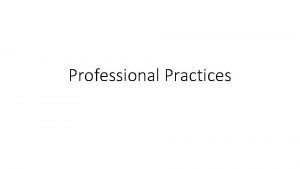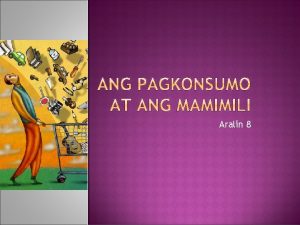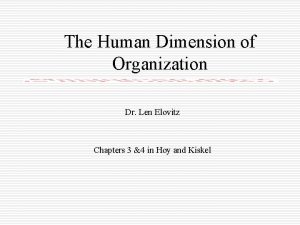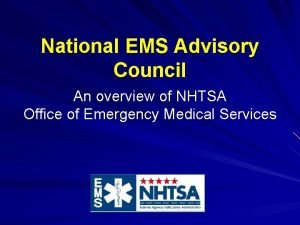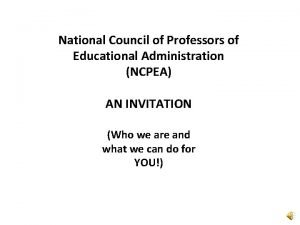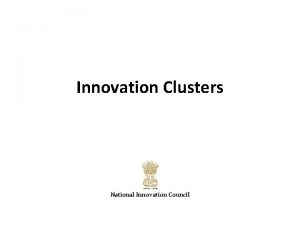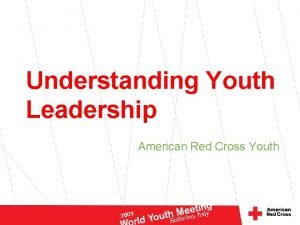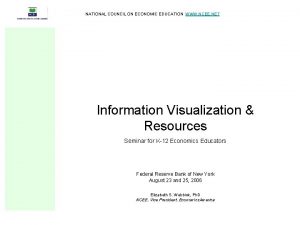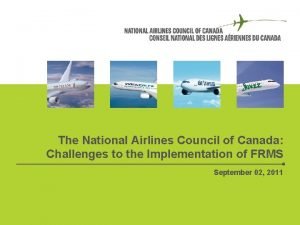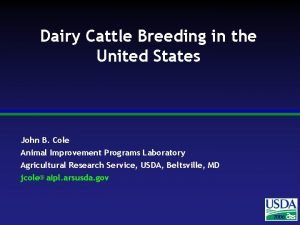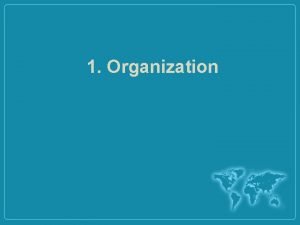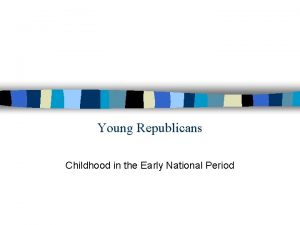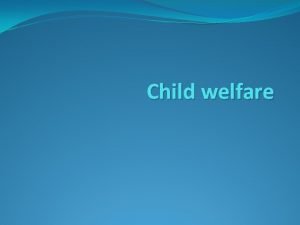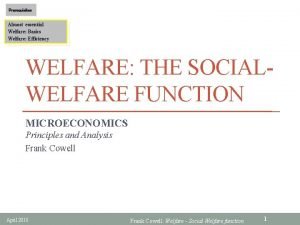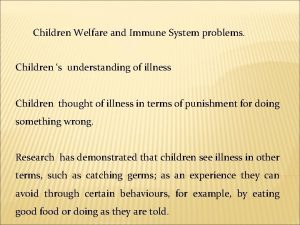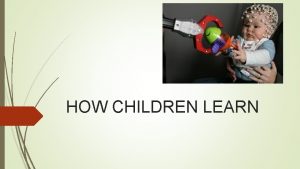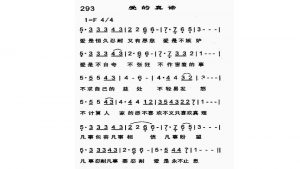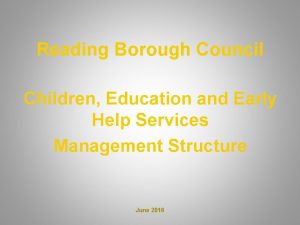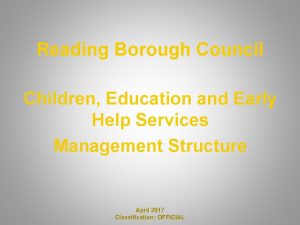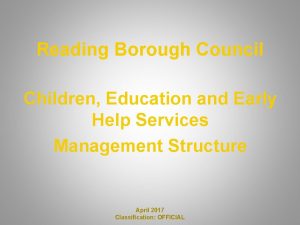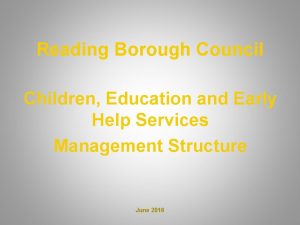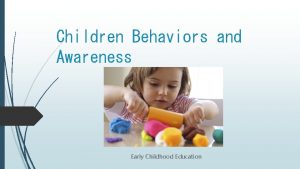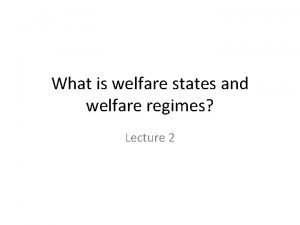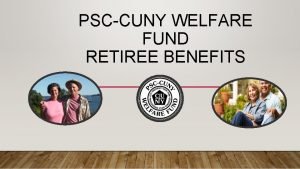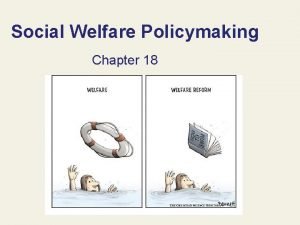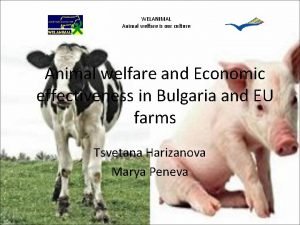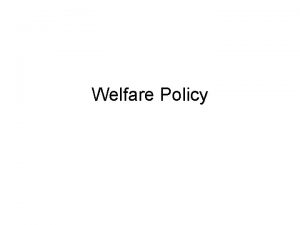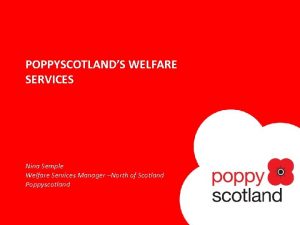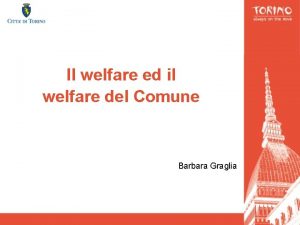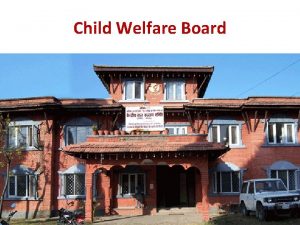Council for the Welfare of Children National Early





































- Slides: 37

Council for the Welfare of Children National Early Childhood Care & Development Coordinating Council 1

A CHILD… A child refers to a person below eighteen (18) years of age or one who is over 18 but is incapable of taking care of himself fully because of a physical or mental disability or condition or of protecting himself from abuse 2

FOUR BASIC RIGHTS OF the CHILD <Survival <Development <Protection <Participation 3

SITUATION of FILIPINO CHILDREN (2006) 4

Philippine Population • 85. 2 million (total population as projected by NSO for year 2005) • 43. 4% or 32. 8 million are children or below 18 years old • 15% or 13. 5 million are below 6 years old 5 Source: NSO 2005

On Families at Risk 33. 7% or 4. 3 M families are at-risk or live below the poverty threshold # # ## 6 Source: NSCB APIS 2002

The Unborn • Many mothers still die due to complications during pregnancy and child birth • Maternal Mortality rate: 172 for every 100, 000 live births • 7 of 10 pregnancies are considered high-risk • The cycle of malnutrition begins with the mother Source: Situation Analysis of Women and Children 7 2003 National Demographic and Health Survey 2003

As of 2000: 2. 6 million or 15% of children (0 -17 years old) are NOT REGISTERED Source: Census 2000 - National Statistic 8 Office

0 ->1 years old • Almost 29 of 1, 000 infants die before reaching the age of one • Leading causes of infant deaths are preventable diseases like poor respiratory conditions, malnutrition and diarrhea • About 300, 000 Filipino babies are born each year with intellectual impairment due to iodine deficiency • How the child develops in these early years sets the stage for later success in school and the character of adolescence and adulthood. Source: National Demographic and Health Survey, 2003 NSCB, 2002 Statistical Yearbook 9 Philippine Progress Report on the MDG 2003

1 ->5 years old • Almost 40 of 1, 000 infants die before reaching the age of five • Despite ECCD Act, many children still do not experience any learning stimulation at home nor access day care services • Only 21% of 6. 5 million 3 -5 year olds go to Day Care Centers • 3 of 10 children, especially in rural villages and urban slums, are underweight. Source: Situation Analysis of Women and Children 2003 National Demographic and Health Survey 2003 10

5 ->10 years old • Almost all Filipino children are in elementary schools but only 7 of 10 Grade 1 students will reach Grade 6 • More children drop-out during the first three years of schooling Source: DSWD Planning Division 2004 11 Dep. Ed – BEIS SY 2002 -2002

10 ->15 years old • 4 of 10 13 -year old children do not move on to high school • Of those who enroll in high school, 5 of 10 eventually drop out • Those who finish high school acquire skills that are below international learning standards. • 1 of 25 adolescent females experience pregnancy before 18 years old • Adolescents are more critical of their parents; about half of them do not find their parents as role models Source: Dep. Ed Planning Division 2004 12 Dep. Ed – BEIS SY 2003 -2004

13

Children in Need of Special Protection These are children who are … • in hazardous & exploitative labor • on the streets • victims of sexual abuse & commercial exploitation • victims of family violence & neglect • separated from or have lost their parents • with various forms of disability • in conflict with the law • girl children • in situation of armed conflict • in ethnic/cultural communities • Muslim • With HIV/AIDS 14 Source: Child 21, Council for the Welfare of Children

Child Labor ® ® ® 4 million child laborers 59. 4% or 2. 4 m are exposed to hazards 6: 10 children are unpaid 60% of them are in agricultural areas 36. 5% of working children do not go to school Child Labor as defined by ILO - Forced labor - Hazardous and exploitative conditions (deep-sea fishing, pyrotechnic industry, mining & quarrying, sugar cane plantation, commercial sexual exploitation, domestic work) - Deprived of education opportunities 15 2001 Philippine Survey on Children by NSO

Street Children Highly visible children: more than 4 hours on the streets National estimate: 45, 000 § 75% with families § 20% refrain from going home § 5% without families Source: DSWD National Project on Street Children, 16 2003 And the Lamberte Study on Streetchildren 2000

Commercial Sexual Exploitation of Children • Trafficking • Child Prostitution • Child Pornography Victims of commercial sexual abuse are: • mostly female, ages 13 – 18 • initiated into the sex trade as early as age 10 • Belong to a large family • mostly out of school/drop-outs Source: Framework of Action Against Commercial 17 Sexual Exploitation of Children

Commercial Sexual Exploitation of Children Total 1, 392 Male 103 Female 1, 289 Source: DSWD, 2000 – 2004 18

Sexual Abuse Total Male Female 22, 742 249 22, 475 §From 2000 – 2005, there were 22, 724 victims of sexual abuses (rape, incest, acts of lasciviousness). §There is a decreasing trend shown by these data from 2000 to 2005. § 98. 9% of these victims are girls. Source: DSWD, 2000 – 2005 19

Cases Filed Per Region Source: DOJ, Special Committee. Date Covered: 1993 -2006 Partial Data 20

Children Affected by HIV • Children under the age of 18 who have close family members living w/ HIV • Those who have lost close family members to HIV and AIDS • Those who are living with HIV *Majority of the children of PLH do not know that HIV and AIDS is in their lives Source: A Deafening Silence… The Situation of Filipino Children Affected by HIV/AIDS 21 A Rapid Assessment

Girl Children • Year 2000, half of the estimated children population are female Girl Children are: • usually victims of child abuse • more affected by HIV/AIDS, STD & teenage pregnancy • victims of illegal recruitment (esp. girls from rural areas) • victims of gender stereotyping in education, child labor, prostitution, etc. 22

Children in Conflict with the Law Profile of children in conflict with the law: usually male • between ages of 14– 17 • elementary graduate • middle child; from a low-income family • charged with property related crimes, rape and murder • exposed to drugs or gang influence 23

Children in Conflict with the Law • In the Philippines, children accused of committing crime as young as nine years old are arrested and detained like adults • As of December 2005 – 1504 (under the custody of BJMP) +1625 (children in RRCYs; 215 came from BJMP) 3129 CICL *more than 10, 000 cases involving children were handled by Public Attorney’s Office • Most of them were charged with minor crimes such as petty theft, sniffing of glue or solvents and vagrancy 24 Source: DSWD 2005 and BJMP 2005

Children in Various Circumstances of Disability • more boys than girls • 201, 869 children with disabilities • 1: 5 children in 0– 6 age bracket has some form of disability • 10– 14 age group prevalence rate has the highest • most common forms of impairment are hearing & visual impairment • more than half are acquired and can be prevented 25 Data source: 2000 NSO Census

Children in Situations of Armed Conflict • As combatants, couriers, guides, medical aides or spies • 13 -18% of armed rebel groups • There were 277 CIAC reported cases from 1989 to 1 Q 2006. Source: OPAPP Report, 26 September 2006 26

Children in Ethnic/ Cultural Communities • 2. 5 million indigenous children ( NCIP est. in 2005: 12 M-all ages) • live in remote areas usually accessible only by foot • have limited access to basic social services • often suffer from discrimination and neglect 27 Data source: 1995 NSO Census

A Child-Friendly Child. Sensitive Society 28

Role of the Prosecutors • making case investigation Child. Friendly (both for child victim and child offender) • immediate resolution of cases involving children • track records on child-related cases for monitoring purposes • implement DOJ Circular relative to Affidavit of Desistance on child-related cases 29

International Commitments • Convention on the Rights of the Child • Optional Protocol on the Involvement of Children in Armed Conflict • Optional Protocol on the Sale of Children, Child Prostitution & Child Pornography • ILO Optional Protocols 138 and 182 • Convention on Discrimination Against Women • Millennium Development Goals • World Fit for Children 30

Government Response National Framework Plans – Philippine National Strategic Framework for Plan Development for Children (Child 21) – National Plan of Action for Children (Medium Term Plan/ 2005 -2010) – National Framework for Children’s Participation: A Guide in Promoting & Upholding Children’s Participation in the Philippines – Framework of Action against Commercial Sexual Exploitation (2000 – 2004) – Comprehensive Program Framework on Children Involved in Armed Conflict – Medium Term Strategic Framework for the Girl-Child 31

Policy & Legislative Initiatives – – – – 1987 Constitution Presidential Decree No. 603 (Child & Youth Welfare Code) Republic Act 7610 (Special Protection of Children Against Child Abuse, Exploitation and Discrimination Act) RA 8172 (ASIN Law) RA 8369 (Family Courts Act) RA 8370 (Children’s Television Act) RA 8972 (Solo Parents’ Act) RA 8980 (Early Childhood Care & Development Act) 32

Policy & Legislative Initiatives – – – – RA 9208 (The Anti Trafficking in Persons Act) RA 9231 (The Act Prohibiting Employment of Children in Hazardous Areas) RA 9255 (Providing Illegitimate Children the Right to Use the Surname of their Father) RA 9262 (The Anti-Violence Against Women and their Children Act of 2004) RA 9288 (The Newborn Screening Act) RA 9344 (The Juvenile Justice & Welfare Act of 2006) E. O. 209 (Family Code of the Philippines) EO 286 s. 2004 - Bright Child Program (part of Child Friendly Movement) 33

Policy and Legislative Initiatives • Executive Order No. 56 (26 November 2001), • Inter-Agency MOA on the Handling and Treatment of Children Involved in Armed Conflict (21 March 2000) • IAC-CIAC Resolution No. 1 -06 34

Programs & Services for Children For 0 -6 years old For 7 - below 18 years old Pre and Post Natal Care Breastfeeding Immunization Growth Monitoring and Promotion Supplemental Feeding Home and Center-based Day Care Effective Parenting Pre-School Education Healthy Lifestyle Elementary Education Secondary Education Alternative Learning System Special Education Comprehensive Program for Child Protection Multi-Grade Teaching Indigenous People Learning System Non-formal Education Youth Development Home and Community Food Production Nutrition Education Social Protection 35 Reproductive Health

All these activities and efforts are done in close collaboration with LGUs and NGO partners, the private sector, the church groups, media and CHILDREN! 36

37
 Council for the welfare of children
Council for the welfare of children Agencies related to welfare services to the children
Agencies related to welfare services to the children List of child welfare agencies in india
List of child welfare agencies in india National program related to children
National program related to children National policies related to child health and welfare
National policies related to child health and welfare Reading borough council children's social services
Reading borough council children's social services Early cpr and early defibrillation can: *
Early cpr and early defibrillation can: * Existanxe
Existanxe National children's science congress projects ideas
National children's science congress projects ideas National service framework children
National service framework children National children's digital health collaborative
National children's digital health collaborative Seo for youth sports clubs
Seo for youth sports clubs National water quality monitoring council
National water quality monitoring council National water quality monitoring council
National water quality monitoring council National employment law council
National employment law council National dignity council
National dignity council National council for special education
National council for special education National aids council tenders
National aids council tenders National crime prevention council cyberbullying
National crime prevention council cyberbullying Arts council national lottery project grants
Arts council national lottery project grants National science council taiwan
National science council taiwan Srfac singapore
Srfac singapore National hispanic council on aging
National hispanic council on aging National computing education accreditation council
National computing education accreditation council National innovation council
National innovation council Ang pagkunsumo ay
Ang pagkunsumo ay National dignity council
National dignity council National staff development council
National staff development council National ems advisory council
National ems advisory council Ncpea
Ncpea National innovation council india
National innovation council india National youth council red cross
National youth council red cross National council for economic education
National council for economic education Arkansas district export council
Arkansas district export council National airlines council of canada
National airlines council of canada National dairy council
National dairy council Uscns
Uscns Early national period education
Early national period education
